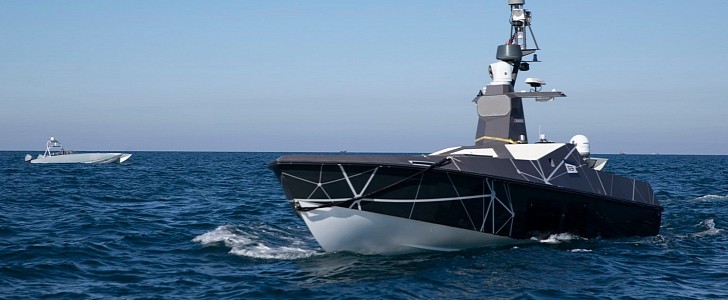Recently, the Royal Navy tested different crewless systems in one of the largest, longest, and most varied exercises in the Middle East. Robot boats and drones were launched from Royal Navy vessels, offering a glimpse of what future naval operations could look like in the region.
More than 50 ships and 80 uncrewed systems from ten nations participated in the combined International Maritime Exercise. The exercise lasted two and a half weeks and it was carried out in the Red Sea, Gulf, Horn of Africa, and Africa's eastern coast, to strengthen relationships and put diverse systems and ways of working to the test.
The Royal Navy's presence in the Gulf was underlined by the minehunter command ship RFA Lyme Bay, which proved critical not just as a hub for the minehunters but also as a testing ground for several autonomous technologies.
The 700X Naval Air Squadron launched the Puma drones from the vessel to test the machine's capabilities. The unmanned system weighs only 15 lbs (7 kg) and can be operated from vessels with or without a flight deck. The 700X has tested Pumas before in the UK, in the Mediterranean, and Arctic, but this was the first time they were operated in the Gulf.
The hand-launched unmanned system was tasked with the surveillance and intelligence gathering, acting like the "eyes in the sky" for the ships.
Speaking of the ships, the Royal Navy also came with the MAST-13 robot boat nicknamed Madfox (short for Maritime Demonstrator For Operational eXperimentation). Developed by aerospace and defense company L3Harris, the 41-foot (13-meter) long high-speed vehicle is capable of operating autonomously. It was given to the Royal Navy a year ago to be utilized for a variety of tasks, including surveillance and force protection.
The crewless systems that took part in the exercise were coordinated under the banner of Task Force X. Its deputy commander was the Royal Navy's Commander Antony Crabb, who believes that the International Maritime Exercise 2022 showed the participants what might become regular sights in the Gulf in just five years.
He predicted that "we will see ships embarking uncrewed systems for missions as easily and seamlessly as embarking a helicopter or seaboat today – perhaps in addition to or perhaps instead of those crewed capabilities."
The Royal Navy's presence in the Gulf was underlined by the minehunter command ship RFA Lyme Bay, which proved critical not just as a hub for the minehunters but also as a testing ground for several autonomous technologies.
The 700X Naval Air Squadron launched the Puma drones from the vessel to test the machine's capabilities. The unmanned system weighs only 15 lbs (7 kg) and can be operated from vessels with or without a flight deck. The 700X has tested Pumas before in the UK, in the Mediterranean, and Arctic, but this was the first time they were operated in the Gulf.
The hand-launched unmanned system was tasked with the surveillance and intelligence gathering, acting like the "eyes in the sky" for the ships.
Speaking of the ships, the Royal Navy also came with the MAST-13 robot boat nicknamed Madfox (short for Maritime Demonstrator For Operational eXperimentation). Developed by aerospace and defense company L3Harris, the 41-foot (13-meter) long high-speed vehicle is capable of operating autonomously. It was given to the Royal Navy a year ago to be utilized for a variety of tasks, including surveillance and force protection.
The crewless systems that took part in the exercise were coordinated under the banner of Task Force X. Its deputy commander was the Royal Navy's Commander Antony Crabb, who believes that the International Maritime Exercise 2022 showed the participants what might become regular sights in the Gulf in just five years.
He predicted that "we will see ships embarking uncrewed systems for missions as easily and seamlessly as embarking a helicopter or seaboat today – perhaps in addition to or perhaps instead of those crewed capabilities."
Royal Navy personnel and ships in the Gulf have been pushing the tech boundaries in the region's largest military workout, #IMX22 / #CutlassExpress
— Royal Navy (@RoyalNavy) March 2, 2022
Drones and autonomous craft were tested extensively aboard @RFALymeBay 1 of 5 UK vessels taking part.
????https://t.co/7gYVqF1yLb pic.twitter.com/9fnVb4qgnD






